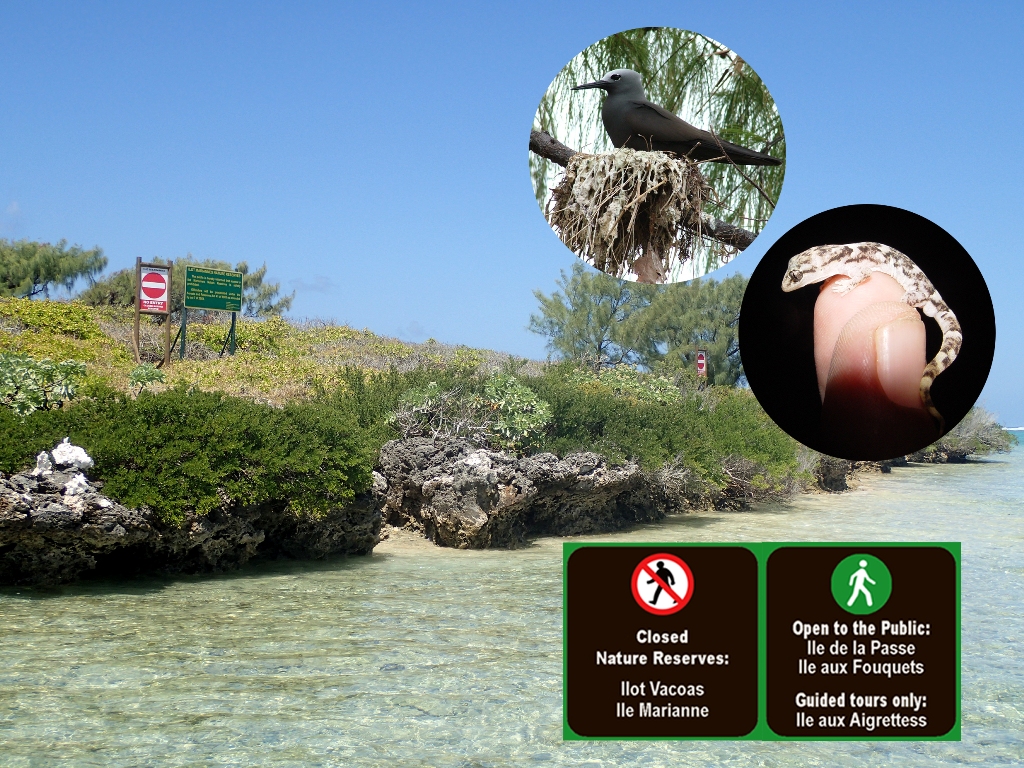| |
The South East Islets – A refuge for nature |
|
|
Partially protected by the sea, these islets provide a refuge for nature and are one of the last places where unique (endemic) Mauritian lizards still live. Mauritian birds also nest on the islets. The islets are home to six species of endemic lizards, three species of native seabirds and three species of endemic land birds. There are 42 plant species that are unique to Mauritius on the islets, 35 of these are threatened. The Mauritian Wildlife Foundation works with Durrell and National Parks and Conservation Service to protect and save these threatened species from extinction. |
|
| Please click on Images to enlarge
|
When you visit, thank you for helping to protect nature and contributing to our work to preserve the rare lizards, birds and plants by following the recommendations for visitors:
- please take your litter home with you
- please stay on the main paths
- please do not feed the animals
- please do not light ground fires, use a portable barbecue
- please check your boats and belongings for any invasive species before leaving for the islets: rats, grass snakes or shrews (rat musqué) can climb into bags or boats, seeds can get stuck to bags or trousers
Download environmental advice for islets:
|
|
| |
|
|
|
Ile aux Aigrettes – Nature Reserve – Guided tours only |
|
|
|
Ile aux Aigrettes was declared a protected Nature Reserve in 1965. Of the approximately 2% of good native forest that remains in Mauritius, a portion of it is found on this island. The Mauritian Wildlife Foundation has been working on Ile aux Aigrettes since 1985 to restore the lowland and coastal vegetation and bring back wildlife.
This protected Nature Reserve now has the best preserved costal ebony rich forest of Mauritius. The island is home to three birds and three lizards as well as over thirty species of plants that are unique (endemic) to Mauritius. To raise awareness and enable us to continue saving nature, we provide guided visits of the island.
|
The birds on the beach are very friendly. So they stay healthy, please do not feed them. They eat insects and flower nectar. Human food makes them sick.
|
Photo: Mauritius Fody (left), Ornate day gecko (top), Telfair’s skink (bottom)
|
|
|
|
Ile aux Fouquets (Ile au Phare) – Open Nature Reserve |
|
|
|
The lighthouse, a national heritage site, was built in 1864 and projected 26 km out to sea. Every evening, it was lit manually by a lighthouse keeper. In 1927, it was abandoned in favour of a light beacon closer to the coast. This historic monument is in poor condition, please watch your step. It is prohibited to climb the building, to deface or damage the site.
Ile aux Fouquets is named after this seabird, the fouquet or Wedge-tailed Shearwater. The islet is also known as ‘Ile au Phare’ after the lighthouse.
We all love seeing these birds fly over the island. Did you know they nest in the grass? With your help, we can protect them: please stay on the main paths and avoid walking in the long grass.
Ground fires are also a big danger to wildlife. You can help reduce risks by using a portable barbecue and taking your used charcoal home.
|
|
|
| |
|
|
| |
Ile de la Passe – Open National Heritage Site |
|
|
|
Ile de la Passe can be considered the gateway to the Indian Ocean. The control of the deep pass leading to the island and then onto the mainland, made it a strategic point during colonial times. Ile de la Passe at the centre of the 1810 navel battle of Grand Port, the only naval battle won by French over the British during the Napoleonic era.
Gunpowder and ammunition were stored in the Powder house (see photo), the unique double wall severed as protection in case of an explosion. The inscriptions on the walls remind us of the passage of soldiers on the island. The Powder House and Hot Shot Furnace, built during the Napoleonic era, are the last of their kind in the southern hemisphere and of great historical importance. Please do not climb the buildings, light fires inside them, litter, deface them or remove bricks.
|
The Bojer’s skink, a unique endemic lizard (see photo), lives in the grass on the south east islets. Skinks have claws and cannot climb out of plastic bottles. You can help protect them by taking your litter home with you.
Please also check your bags and boats before leaving for the islets to make sure you are not accidentally carrying invasive species with you.
|
|
|
| |
|
|
| |
Ilot Vacoas, Ile Marianne - Closed Nature Reserves |
|

|
Ile Marianne and Ilot Vacoas are home to this tiny gecko, nactus coindemirensis. The lesser night gecko is just the size of your fingernail and is only found in Mauritius. The lesser night gecko was reintroduced in 2011 under the Mauritius Reptile Recovery Programme. Seabirds also nest in the grass and trees on the islets. Ile Marianne is in fact named after the Lesser Noddy, a seabird known locally as the Marianne.
|
To reduce the risk of this small gecko and other species going extinct, public access to Ile Marianne and Ilot Vacoas is prohibited. Both islets are declared as Closed Nature Reserves.
Visitors and boats present a potential risk, as they could transport exotic invasisive species. A single shrew (rat musqué) has in the past decimated entire populations of lizards on offshore islets. Most people help protect nature and only visit the open islets (Ile aux Fouquets and Ile de la Passe).
|
|
|
| |
|
|
| |
Please click on images below to see the description;
|
|
| |
|
|